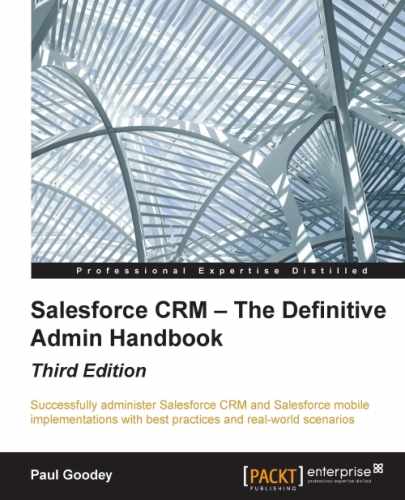By way of introduction, and for the sake of completeness, the upcoming section describes the core features of external server-side mash-ups. We will briefly look, in a little more detail, at the capabilities, features, and implications associated with the use of server-side mash-ups.
Server-side mash-ups are a specific example of an external services mash-up. This is where external systems can either serve the request for data from Salesforce as a client or use data presented by Salesforce and mash the composite data in an external system.
These mash-ups typically use web services and are most often provided by organizations using web APIs, which describe how the service can be accessed by a client application over the Internet and are executed on the remote system that is hosting the service.
A more formal definition of a web service is provided by the World Wide Web Consortium (W3C), which as detailed on their web page (http://www.w3.org), is an international community where member organizations, full-time staff, and the public work together to develop web standards.
The definition of a web service by the W3C is (http://www.w3.org/TR/ws-gloss/):
A Web service is a software system designed to support interoperable machine-to-machine interaction over a network. It has an interface described in a machine-processable format (specifically WSDL). Other systems interact with the Web service in a manner prescribed by its description using SOAP-messages, typically conveyed using HTTP with an XML serialization in conjunction with other Web-related standards.
Although the web service definition for the machine-to-machine interaction by the W3C refers to machine-to-machine interaction using Simple Object Access Protocol (SOAP), there is another protocol that is becoming increasingly popular today, known as Representational State Transfer (REST). This is mentioned for information only, and we will not go into any further detail about web services in this book.
Within Salesforce CRM, there are typically two types of client-side mash-ups, namely client-side services mash-ups and client-side presentation mash-ups.
Similar to server-side mash-ups, client-side services mash-ups can also be used to call web services or consume websites and feeds. They can be used to invoke the Salesforce CRM web services API from within the browser. Client-side services mash-ups require more complex programming than client-side presentation mash-ups and typically rely on the technologies associated with web services.
Client services mash-ups and external services mash-ups are useful to organizations that need to access information from various systems that usually serve a business data process and interact in real time. Specifying and developing these types of mash-ups needs to be carefully evaluated to determine the required effort and resources.
Client-side presentation mash-ups are the least complex mash-ups and can be composed relatively quickly. Here, live data and functionality from multiple sources are embedded on a web page, which requires data from the Salesforce platform with you can mash up with the non-Salesforce data and functionality.
Client presentation mash-ups in Salesforce can be composed using Visualforce, HTML, and JavaScript, which can often be copied and pasted by nontechnical users and can immediately add value to a web application.
Having briefly outlined the nature of client-side mash-ups, we are now going to look at how they can actually be created in Salesforce CRM. As shown earlier, the enabling technology is provided by the Salesforce platform with the use of the web page framework known as Visualforce.
The best way to guide you through the use of new technology is by demonstrating how to use it with an example. Here, we are going to compose a client-side presentation that displays a Google map widget, which displays Google map location details for a given company record in Salesforce.
The Google map will be presented to the user in Salesforce CRM after selecting an appropriate account record, and live Google map information will be displayed right from within the relevant account detail page. The mash-up will be composed by creating a new Visualforce page with the required Google map widget and then adding a new section to the account detail page where the Visualforce page will be included.
